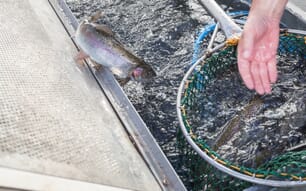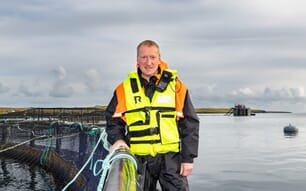Developed by Schering-Plough Animal Health Corporation, AQUAFLOR Type A Medicated Article has been proven worldwide to be effective against a wide range of bacteria in several aquatic species. It is also highly palatable and has an excellent safety profile for fish, human food and the environment.
Unlike sulfa drugs and tetracyclines, this unique antibiotic was developed specifically for use in food animal species. Studies have shown that AQUAFLOR can be used in trout and other freshwater-reared salmonids, from sac fry to food fish, with no reduction in feed consumption or growth. The product's short, 15-day withdrawal period gives producers ample flexibility when marketing fish.
Effective against coldwater disease
Trials conducted with the U.S. Fish and Wildlife Service have shown AQUAFLOR to be highly effective against coldwater disease. In steelhead trout, for example, fingerlings treated with AQUAFLOR had 60 percent less mortality than untreated controls, even though initiation of treatment was delayed far beyond what would be typical in most field situations.
"Coldwater disease often results in prolonged, chronic mortality and is one of the most economically significant diseases of salmonid aquaculture - not just in the U.S., but also worldwide," says Richard Endris, Ph.D., aquaculture research program manager for Schering-Plough Animal Health.
"In fingerlings and food fish, the disease produces lethargy, poor appetite and dark coloration," he adds. "Infected fish can also develop spinal deformities, which reduce their value."
Trials have also shown that fish consume feed medicated with AQUAFLOR at the same rate as unmedicated feed - even when AQUAFLOR is used at 10 times the recommended dose rate.
"The palatability of an antibiotic is extremely important because it ensures optimum feed and antibiotic intake during the critical treatment period," Dr. Endris says. "It also helps fish stay on feed in the face of a severe disease challenge."
AQUAFLOR is a highly stable product, both as a packaged premix and in feed following high-temperature extrusion. For salmonid feeds, it can be incorporated prior to pelleting or coated onto pellets. Schering-Plough Animal Health recommends using feed medicated with AQUAFLOR as the sole ration for 10 consecutive days. Treatments should be discontinued 15 days before marketing. AQUAFLOR is not approved for use in breeding stock.
VFD ensures correct usage
AQUAFLOR is the first in-feed antibiotic in aquaculture and the second for all food-animal species to be classified by the FDA as a Veterinary Feed Directive (VFD) drug. VFD is a category established in 1996 to help the agency more closely control new therapeutic products, primarily antimicrobials, and their use in food animals. The VFD classification applies only to new in-feed therapeutics approved by FDA after 2000. Fish farmers may obtain VFD drugs through normal feed distribution channels, but they will require a signed Veterinary Feed Directive from a licensed veterinarian.Dr. Dave Erdahl, fisheries biologist and Branch Chief of the Aquatic Animal Drug Approval Partnership (AADAP) Program of the U.S. Fish and Wildlife Service, Bozeman, Mont., doesn't think the VFD process will be a major issue for most producers raising trout and other freshwater-reared salmonids.
"The role of veterinarians in aquaculture is expanding," he says. "There are already a considerable number of operations working directly with consulting veterinarians or veterinarians on staff with state and federal agencies.
"Like anything new, it may be a bit problematic at first," he adds, "but I look at the VFD process as a 'growing pain' for our industry. If we want new products to maintain fish health, we have to comply with the new regulations. It's that simple."
While AQUAFLOR is relatively new to the U.S. market, it has been used successfully for more than 15 years in other major aquaculture markets, including Japan, Europe and Latin America, to treat diseases in other farm-raised aquatic species. Since October 2005, AQUAFLOR has been approved for control of mortality in catfish due to enteric septicemia (ESC) associated with Edwardsiella ictaluri. Schering-Plough Animal Health is actively seeking claims for other disease-causing pathogens in freshwater-reared salmonids, catfish and other species.
NUFLOR (florfenicol), a sister product to AQUAFLOR, has been used successfully in the United States since 1996 to treat respiratory disease in beef and non-lactating dairy cattle. More recently, NUFLOR (florfenicol) Oral Solution and NUFLOR (florfenicol) Premix were approved for use in swine.




